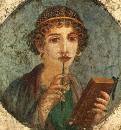 The world is full of madcap ideas that don’t come to fruition. But thankfully there’s always a place to talk about them, even if they end up not getting realized.
The world is full of madcap ideas that don’t come to fruition. But thankfully there’s always a place to talk about them, even if they end up not getting realized.
Here’s a concept for an art installation which I came up with to accompany The Berkeley Symphony Orchestra‘s upcoming concert next Thursday of works by Paul Dresher (Cornucopia), Esa-Pekka Salonen (Five Images After Sappho) and Beethoven (Symphony No. 3, “Eroica”).
The orchestra’s music director, Joana Carneiro, asked me to think of a way to help contextualize Salonen’s work for audiences. The idea turned out to be far too ambitious to realize in the limited amount of time we had. But, hey, a girl’s gotta dream.
Concept for an installation to accompany Esa-Pekka Salonen’s Five Images After Sappho by Chloe Veltman:
Historical Background:
The idea for the installation stems from an account in Margaret Reynolds book The Sappho Companion of an excavation that took place in Egypt at the end of the 19th century. The findings greatly changed our level of understanding of Sappho. Reynold’s account describes an archaeological dig by British scholars Bernard Grenfell and Arthur Hunt who set out for Egypt in 1895 in the wake of news that Egyptian farmers had turned up pieces of papyrus as they ploughed new fields. Reynolds writes:
“They settled on a site at a small town about 120 miles south of Cairo, Oxyrhynchus (now called Bahnasa). On the outskirts of the town was a group of low mounds. Almost as soon as they began to dig, Grenfell and Hunt realized that it was the huge rubbish dump of a once-thriving town dating from the period of Hellenistic Egypt. The rubbish had been thrown out in about the 5th century AD, but quite a lot of it was much older, often dating the from the 2nd to 3rd centuries AD.”
Among the scraps was a tiny fragment of dating to the 3rd century AD — a copy of Sappho’s poem, then previously unknown, named “To the Nereids”. Gradually, more Sappho Fragments showed up in the rubbish pile, scraps of which had been shipped back to Oxford by Grenfell and Hunt in biscuit tins. 213 Fragments have surfaced from the dig to date.
Musical Background:
Fragmentation is one of the central ideas in Salonen’s Five Images After Sappho. In the program notes for the 1999 world premiere of his work, the composer wrote:
“If we imagine the history of art as some kind of Darwinian survival game, Sappho stands out as a genetic miracle. No (almost no) whole organism (poem) has survived; instead we have a couple of dozen pages’ worth of fragments. Some of them are almost complete little poems, most of them are isolated groups of words or single words far apart. 

Almost every generation of poets has tried to translate these scattered messages from a woman of whom we know very little. As always, interpretation tells more about the interpreter, and his time and culture, than the work itself…It is the fragmentary nature of the material, and therefore an almost open form, that makes Sappho so fascinating to set to music.
Using tiny fragments of Sappho’s poetry, Salonen captures the multi-faceted, interpretatively-open nature of Sappho’s legacy. In the Images, we come to understand the poet as boasting many identities – wife, lover, mother, sage, debutante, poet, suicide, heretic, devotee…
The Installation:
The installation seeks to bring together these historical and musical components of Sappho’s legacy by marrying a visual representation of Grenfell and Hunt’s rubbish heap with writings, images and sound/music excerpts from the cannon of artistic works inspired by Sappho.
The Experience:
A huge rubbish pile made of tiny scraps of papyrus* will greet concertgoers when they enter the lobby of Zellerbach Hall for the concert. The bigger the heap, the more awe-inspiring. Each bit of visible papyrus will have text on it e.g. lines of Sappho’s poetry, lines from poems/plays/novels/non-fiction works etc. by other poets through the ages inspired by Sappho. Visual depictions of Sappho by artists through the ages (paintings, etchings etc) will also be added to the pile. Some of these texts and images will look like they’re flying from / falling off the pile, by being suspended from wires above and to the side of the heap. A soundscape of musical and poetic works inspired by Sappho as well as voicings of translations of Sappho’s poetry will be piped through speakers into the lobby to add to the atmosphere. The cumulative effect should be one of infinite interpretation and fragmentation.
In addition, a papyrus scrap bearing a small piece of Sappho’s poetry could be included inside every concertgoer’s program.
*The papyrus pieces can be made from bits of tea-stained white sheeting. Foam, papier-mache or some other lightweight, bulky material can be used to make the base of the sculpture.
